In other words, I'm not planting anything outside until at least March. I envy those in warmer climes.
While I wait for my seeds to arrive and the seed-starting season to begin, I thought I'd share an assessment of some vegetable varieties from last year. Maybe they'll help you decide what seeds are worth buying for your own garden. Or maybe which varieties to look for at the market? Since I suffered a few setbacks, I'm including only the varieties that matured and produced, noting susceptibility to disease, yield, and flavor.
First, there's the Bull's Blood beet. While my plants failed to produce any bulbs, I did harvest a few meals' worth of lovely dark red leaves, which is what this heirloom variety is noted for. Beet greens have a flavor similar to spinach or Swiss chard (they're all close relative) and look great in salads--though, beware, they'll turn your pasta pink! Definitely something different with added decorative potential.

A 'Carmen' sweet pepper...great for roasting...
Next, there was the Carmen sweet pepper, an Italian variety bred especially for roasting and grilling. The walls are thinner, with a lower water content than your grocery store bells, but the sweet flavor is more concentrated and the roasted peppers weep less as a result. While you can use this variety the way you'd use any other sweet pepper, I don't recommend it sauteed or stir-fried. If you like to roast and freeze peppers, this is probably the variety to get. Regarding the plants, they are rather tall and seem to like a bit of support. Yield is pretty good, though my plants produced more towards the end of the season.

A variety of tomatoes from the garden: 'Early Girl,' 'Big Boy,' and a 'Striped German' on the bottom.
Tomatoes are always a big crop for me, and my goal last year was to branch out and try a few different varieties.
Because I like to can a lot of salsa, I thought I'd try a paste variety. Burpee's Big Mama, with its big, enticing fruits, looked like a variety worth getting, but as noted in a previous entry, it's very susceptible to blossom end rot. Initially I had assumed this was simply related to my container grown plant, but as the in-ground tomatoes matured, I quickly discovered this was not the case. I followed the same watering schedule for all my plants, but it would appear that this variety prefers that the soil remain moist at all times. Reading more about Roma/paste varieties, this problem is quite common.
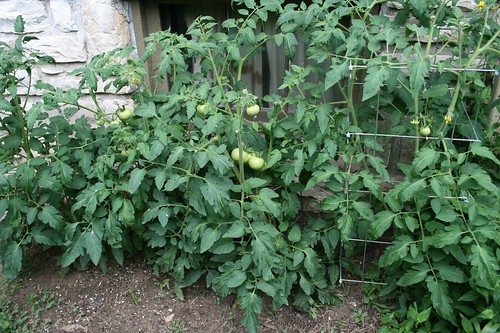
Overgrown 'Big Boy' bushes in the south garden.
If you like productive hybrid beefsteaks, I can heartily recommend the Big Boy bush variety. The flavor is good and sweet, if not terribly unique, and grown in a good full-sun location it should produce nice big fruits.

'Early Girl' tomatoes (with a 'Big Boy' on the top right).
Another hybrid I tried as the Early Girl, a smaller early variety that failed to produce anything substantially earlier than the other varieties. Taste was somewhat bland, too, so I can't say I'll be planting it again.
I will, of course, be planting some seeds from the Cherokee Purple tomatoes I planted last year. It's not as sweet as the ever-popular Brandywine, but there is a mellow smokiness that adds a depth I really like. It makes a fantastic salad or bruschetta, and is pretty good on its own too.
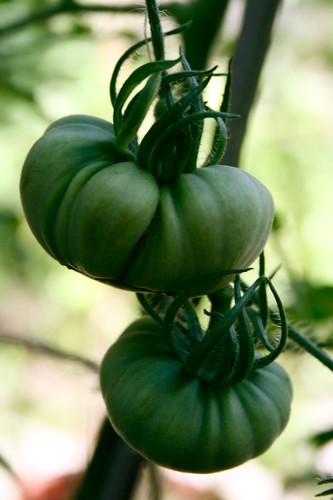
Young 'Cherokee Purple' tomatoes on the vine.
I try a lot of different heirloom varieties when I go to the market and save seeds from the varieties I like. Last year I planted some Striped German plants from seeds I saved in 2007. While the plants aren't as leafy and robust as the Cherokee Purple, they have a certain "weediness" that's part of the heirloom charm. The fruits are a mottled orange and red inside and out and like the Cherokee Purple prone to a bit of cracking at the shoulders. More acidic than sweet but fairly balanced overall. I like it more on sandwiches or in addition to another tomato in a salad than by itself.
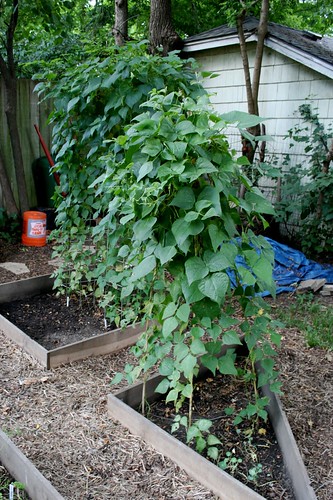
'Blue Lake' pole beans.
Another vegetable I always make an effort to include is the snap bean. In 2008 I tried the Blue Lake pole bean, which produced consistent yields from August to September. It likes lots of sun and water when it begins to flower (like most pole beans) and seemed to hold up through some bouts of mold. The beans were around 5"-6" long with a straightforward snap bean flavor and texture. Overall, this variety seems dependable.
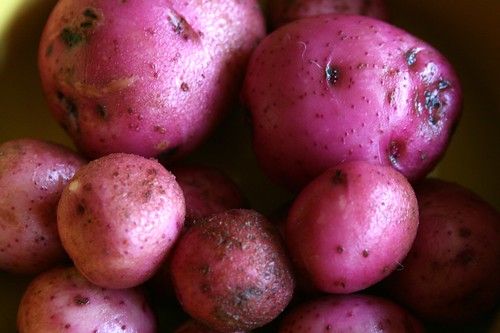
'Dark Red Norland' new potatoes, freshly scrubbed.
I've previously mentioned my delight at growing my own potatoes, certainly one of my favorite vegetables and one I would like to keep growing in the future. I tried the Dark Red Norland, which did not garner high yields but was dependable in the production of tasty new potatoes. Thin-skinned and waxy, I would say they are best steamed and paired with green beans (preferably a filet variety) in a fresh nicoise style salad. Or make a light and vinegary potato salad.
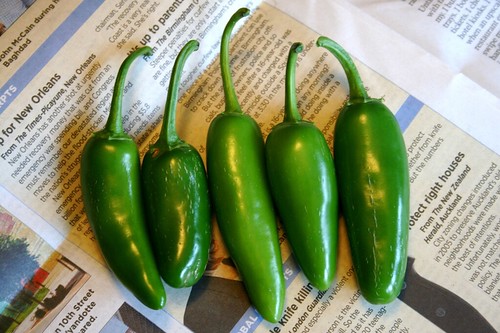
'Jalapeno M' hybrid jalapeno peppers--small, but tasty!
Lastly, I planted the ever-dependable Jalapeno M, a hybrid I attempted in Vegetable Garden 1.0 and was mostly pleased with. It doesn't produce the big honking jalapenos you might be lusting after, but the yields are consistent and dependable, even after the high heat of mid-summer. The bushes are nice and compact and don't seem to require any support. The flavor is classic jalapeno, a low to medium heat that's great for salsa. Also good pickled.
Was there anything you tried last year that you would plant again or recommend to others?
2 comments:
Hi! I'm glad you're back! I have been having trouble with my tomatoes and cucumbers getting diseased and dying. The tomatoes usually give a crop first, but I'm getting fewer and fewer cucumbers.
Do you rotate yours? I'm thinking about planting a couple tomato plants in my new bed in the front yard. Do the heirlooms get diseases? Oh, I think the yellow plum tomatoes that come back from seed are heirloom. I can't remember if they got diseased as soon.
Thanks for reading!
I'm not rotating my tomatoes, since most resources advice to keep them in the same plot each year. I am following a rotation schedule on the rest, though.
I would say that if you have recurrent diseases in the same plot each year, you might want to rotate the crop out w/something else from an unrelated family.
I'm following my cucumbers and other cucurbitaceae plants with beans this year, if that's any help.
As far as heirlooms go, I'm going to say it depends on the variety. Do you know what particular disease your plants suffered? Look for a variety resistant to that disease.
Post a Comment